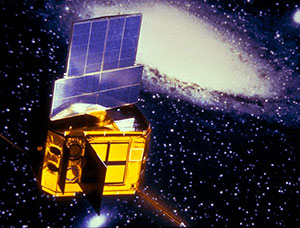
During the period from 1967 to 1969, the European Space Research Organization (ESRO) studied two separate missions -
- a European X-ray observatory satellite, as a combined X- and gamma-ray observatory (Cos-A)and
- a gamma-ray observatory (Cos-B).
ThisEuropean Space Agency (ESA) satellite for direct-pointing and lunar-occultation observation of X-ray sources beyond the solar system was launched into a highly eccentric orbit (apogee 200,000 km, perigee 500 km) almost perpendicular to that of the moon on May 26, 1983. The instrumentation includes two low-energy imaging telescopes (LEIT) with Wolter I X-ray optics (for the 0.04-2 keV energy range), a medium-energy experiment using Ar/CO2 and Xe/CO2 detectors (for 1.5-50 keV), a Xe/He gas scintillation spectrometer (GSPC) (covering 2-80 keV), and a reprogrammable onboard data-processing computer. Exosat was capable of observing an object (in the direct-pointing mode) for up to 80 hours and of locating sources to within at least 10 arcsec with the LEIT and about 2 arcsec with GSPC
Exosat was the first ESA spacecraft to carry on board a digital computer (OBC), with its main purpose being scientific data processing
No comments:
Post a Comment